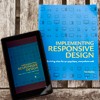(Note: The audio sync is a little off for some sequences as slideshare's tools aren't all that precise)
Summary
Responsive Design is a way of making a single website that works well on mobile, tablet and desktop browsers. Back in 2010 Ethan Marcotte, first coined the term "responsive design" and described it as having 3 components:
- Flexible Images
- Fluid Grids
- CSS Media Queries
Well it seems Ethan let quite a few cats out of the bag with this one and we've been trying to herd those cats ever since.
What started as exclusively a front-end web design technique has expanded to include a whole new range of both front-end and server-side programming techniques. The real challenge came when we also suddenly discovered that tried and true practices for project management and creative concept development started to fall apart. It’s not practical to create photoshop mockups of ever page in a site at every device size - there’s simply too many variables to account for in graphic design software.
Responsive Design requires a new process for creating websites and new ways of interacting with teams and clients.
This presentation will outline a birds-eye-view of Responsive Techniques, Strategies, Tools, and Gotchas of RWD. It will focus on some of the new workflow techniques needed and cover some suggestions on how to learn more.


Comments